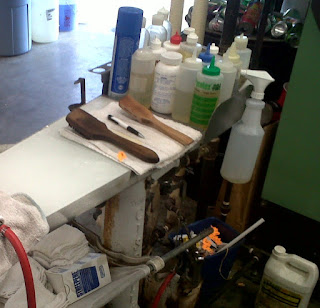Most dry cleaners are familiar
with the OTPR (oily type paint remover) Pyratex®, manufactured by Streets®,
an outstanding stain remover and an industry staple for many years. Pyratex® has the ability to quickly
cut through exceptionally heavy stains such as grease, shoe polish, lipstick,
paints and oils, just to name a few. Today I have the opportunity to tell you about a new type of Pyratex® -
Pyratex LV®,
a virtually odorless, color friendly, leave on, no flush, OTPR, that will not
affect the flash point in solvents. Now, I know what you are thinking,
"Mike, it is your job to sell Pyratex LV®, so you may be a bit biased" and I am, but those
customers of mine who have already purchased the new Pyratex LV®
are seeing that this new product is finding a very useful place on their
spotting board, right along side the Pyratex® they have been using for
years and is making their jobs much easier.
Just like the Pyratex®
that dry cleaners have been using for generations, Pyratex LV®
is formulated to take on the heavy-duty stains.
It can handle paint, oil and grease stains, as well as lipstick and
cosmetics. It lubricates, lifts and
suspends soils to prevent it from redepositing on fabrics. It is virtually odorless. Another nice aspect of the Pyratex LV®
is the fact that it does not need to be flushed from fabrics when cleaning in perc,
HFHC and LFHC. It can be used
effectively in D5 solvent, but will require flushing with steam, water or other
flushing agents. Even better, it does
not need to be flushed in wetcleaning or laundry. Yes, that is right you can use Pyratex LV®
in your wetcleaning and laundry. In fact for those of you using the "old" Pyratex, I would think of the new Pyratex LV as "Pyratex for laundry".
Dry cleaners know that one of the
biggest challenges in laundry is the removal of food greases, oil stains,
cosmetics, waxes and so on. Washing and
wetcleaning does an excellent job at removing water soluble soils, but the real
challenge comes when faced with the solvent soluble soils in
wash/wetcleaning. Quite often a dry
cleaner will take valuable time and added expense by first cleaning a garment
in their dry cleaning machine to remove these oily type stains and then
laundering them, that is if they can be dry cleaned. However, by using Pyratex LV®
as a pre-spotter, you can eliminate having to go to the dry cleaning machine to
first remove grease stains before laundry.
Pyratex LV® is sold by Streets®authorized distributors. All ingredients
are biodegradable. It contains no
Proposition 65 listed ingredients or halogenated compounds and is designed to
comply with California 2013 VOC regulations.
This leads me to the question,
how do you remove grease stains in laundry and the answer is simple - you use
Pyratex LV®!
















